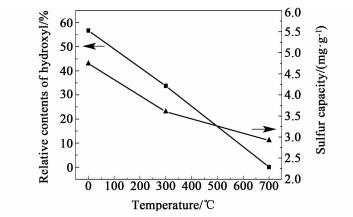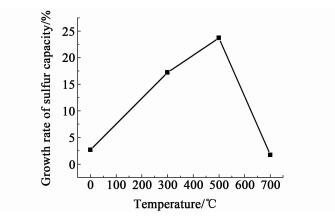纳米管是当前研究的热点材料,在能源、环保、医药及生物工程等诸多领域表现出优良的性能[1-3]。但目前研究较多的碳纳米管存在价格昂贵,改性难度大、具有可燃性等缺点[4],影响其在各个领域的应用。埃洛石纳米管(halloysite nanotubes,缩写HNTs)是一种价格低廉的天然纳米管,因其具有易改性、生物相容性良好等优点[5]成为目前国际材料领域研究的热点材料[6-8];从结构形态上看[9],埃洛石纳米管与碳纳米管具有一定的相似性,可以在一些领域内成为碳纳米管的潜在替代材料[10-13]。已有研究显示,HNTs可加强材料的性能[14],也可在物质吸附、存储、输运、催化以及电化学储能等方面表现出优良的性能[15-19]。然而,目前对于埃洛石纳米管的理论研究较少,应用领域有待拓展。
埃洛石纳米管是双层1: 1型硅铝酸盐纳米管,其分子式为Al2Si2O5(OH)4·nH2O,(n=0或2)[5]。从管道结构上看[9],HNTs管内含有丰富的铝羟基,管边缘含少量的铝羟基和硅羟基,外表面是Si—O—Si基团。材料性能与其结构特点息息相关,已有研究发现,埃洛石纳米管表面结构能显著影响它的催化活性[11]、对药物分子控制释放性能[16-17]和重金属离子吸附性能[18-19]等。然而,关于埃洛石纳米管表面结构对其吸附脱硫性能影响的研究较少。
本研究采用煅烧和酸处理的方法对埃洛石纳米管进行改性,考察了改性前后埃洛石的表面结构变化,以及表面结构对吸附脱硫性能的影响,以期为进一步研究提供理论依据。
1 实验部分 1.1 原料和试剂硫酸、噻吩、正辛烷、溴甲酚绿、甲基红、甲基橙、无水乙醇均为分析纯,购买于天津光复精细化工研究所;埃洛石纳米管(HNTs)购买于广西。
1.2 原料处理取一定量的HNTs置于坩埚,放入马弗炉,从室温以一定速率升温,一定温度后保温,样品分别在300、500和700 ℃下煅烧4 h,随炉冷却,得煅烧处理样品,分别记为HNTs-300、HNTs-500和HNTs-700。取4 g不同温度煅烧后的埃洛石纳米管分别加入一定量0.5 mol·L-1的H2SO4溶液,缓慢升温到70 ℃,恒温水浴搅拌3 h时间,抽滤,洗涤至中性,80 ℃烘干,研磨过100目筛,得酸处理样品,分别记为HNTs-ac,HNTs-300-ac,HNTs-500-ac,HNTs-700-ac。
1.3 静态吸附实验将噻吩溶解于正辛烷溶液中,配制成噻吩含量约为3 000 μg·g-1的模拟汽油。分别取10 mL的模拟汽油置于锥形瓶,加入一定量的HNTs、煅烧HNTs、煅烧HNTs经酸处理后样品(m(油): m(剂)为20: 1,下同),于30 ℃搅拌5 h,静态吸附反应后离心,采用GB-T 380燃灯法[20]对上层清液测定硫含量,计算每个产品的硫容量。
1.4 表征采用荷兰Panalytical公司X′Pert Pro型X射线衍射仪测定样品的晶相结构。辐射源为Co_Kα,扫描角度范围为10°~70°;采用Nexus FT-IR红外光谱仪测定样品的傅里叶变换红外吸收光谱,扫描范围4 000~300 cm-1;采用PhliPs公司的XL30ESME型扫描电镜(SEM)观测样品的微观形貌。
2 结果与讨论 2.1 煅烧对HNTs结构特征的影响图 1为HNTs的TEM图。

|
| 图 1 HNTs的TEM图 Figure 1 TEM images of HNTs |
| |
从图 1可以看出,埃洛石纳米管为中空管状结构,管径大小不一,管外径约35~50 nm,内径约20~25 nm,管内外壁较光滑。
从图 2 XRD表征结果可以看出,埃洛石纳米管(HNTs)在2θ=14.08°处衍射峰对应的d值是0.730 nm,这是0.7 nm埃洛石纳米管的特征峰(001面)[21-22]。HNTs和300 ℃煅烧HNTs的谱图十分相近,埃洛石的各种衍射峰清晰可见。500 ℃煅烧后,HNTs的特征衍射峰强度有一定减少,但仍较清晰。700 ℃煅烧后,HNTs的特征峰消失,在20°~35°间出现1个很宽的衍射锋,说明此时埃洛石纳米管转变为无定型结构[23]。煅烧前后样品在2θ=23.35°(d001=0.442 nm)处都有衍射峰,说明埃洛石纳米管的热稳定性很高,高温处理后,仍然保留了管状结构[15]。

|
| 图 2 HNTs及煅烧后HNTs的XRD图 Figure 2 XRD patterns (Co_Kα) of HNTs and calcinated HNTs |
| |
为进一步验证管状结构,对其进行SEM表征。图 3是HNTs及不同温度下煅烧HNTs的SEM图。

|
| 图 3 HNTs及煅烧HNTs的SEM图 Figure 3 SEM images of HNTs and calcinated HNTs |
| |
由图 3可以看出,随着煅烧温度的提高,HNTs出现黏连现象,但其管状结构仍然保持良好,再次证明了埃洛石纳米管具有很高的热稳定性能。
2.2 煅烧温度对HNTs羟基含量和脱硫性能的影响图 4为煅烧和酸处理HNTs的红外谱图。

|
| 图 4 煅烧和酸处理HNTs的红外谱图 Figure 4 FTIR absorbance spectra of calcinated and acid-treated HNTs |
| |
已有研究显示,埃洛石中FTIR吸收峰的位置和归属如下[10, 24-25]:峰位于3 699 cm-1处为内表面羟基伸缩振动,3 622 cm-1处为内羟基伸缩振动,912 cm-1为Al—O—H内羟基的弯曲振动。如图 4a)所示,HNTs与HNTs-300的红外谱图类似,在3 699、3 622和912 cm-1处埃洛石纳米管各羟基振动峰清晰可见,但对比发现HNTs-300各羟基振动峰强度稍有减弱,可能由于表面和层间吸附水的脱除[21, 26]。样品HNTs-500与HNTs-300的红外谱图对比,发现其位于3 699 cm-1处内表面羟基伸缩振动峰和3 622 cm-1处内羟基伸缩振动峰峰强度明显减弱,位于912 cm-1处Al—O—H内羟基的弯曲振动峰消失,可能由于500 ℃时发生剧烈失羟基作用[26]。HNTs-700的红外谱图中位于3 699、3 622和912 cm-1处埃洛石纳米管羟基振动峰均消失,说明700 ℃煅烧后,埃洛石纳米管表面羟基数量接近于0。由此可知,随着煅烧温度的增加,HNTs的表面羟基含量逐渐减少。
图 5是HNTs的羟基含量和硫容量随煅烧温度变化的分析图。

|
| 图 5 不同温度煅烧HNTs的羟基相对含量和容硫量 Figure 5 The relative contents of hydroxyl and sulfur capacity of HNTs calcinated at different temperatures |
| |
如图 5所示,其羟基含量与硫容量均随煅烧温度的增加而减少,因此认为埃洛石纳米管羟基含量对脱硫效果有影响,其脱硫效果随羟基含量的减少而减少。500 ℃煅烧后,埃洛石纳米管的羟基含量减少,但容硫量并没有因此降低,反而增加了。分析原因,可能是500 ℃煅烧时,由于埃洛石管内的部分羟基发生断裂或消失,由此而产生的H+,与剩余的羟基转化成B酸中心[11],导致HNTs-500的脱硫能力显著提高。因此,推测HNTs-500脱硫性能的提高与B酸活性位的产生有关。
实验发现酸处理可以一定程度增加煅烧后埃洛石纳米管的羟基含量,为了进一步证明羟基含量对脱硫效果的影响,采用酸处理改性煅烧后HNTs。
2.3 酸处理对煅烧改性HNTs的羟基含量和脱硫性能的影响图 4b)为HNTs及煅烧改性HNTs样品经酸处理后的红外谱图。对比图 4a)酸处理前的红外谱图,发现HNTs-ac与HNTs羟基相关吸收峰(3 699、3 622和912 cm-1处)的强度大致相同,HNTs-700-ac与HNTs-700的羟基相关吸收峰均消失,说明对于羟基未脱除和已脱除完全的样品,酸处理对其羟基含量无影响。而样品HNTs-300-ac、HNTs-500-ac羟基相关吸收峰的强度均有明显增强。因此,认为一定条件下酸处理可以还原其高温煅烧脱除的羟基。
以样品HNTs-300和HNTs-300-ac为例[如图 4c)所示],可以看出,酸处理在一定程度上能够增加煅烧后HNTs的羟基含量。
图 6给出了酸处理后煅烧改性HNTs的容硫量增长率。

|
| 图 6 酸处理后煅烧改性HNTs的容硫量增长率 Figure 6 Sulfur capacity growth rate of different calcinatd HNTs after acid treatment |
| |
如图 6所示,不同温度煅烧的HNTs样品,经过酸处理后,硫容量都有不同程度的增加。其中,HNTs-ac和HNTs-700-ac的硫容量增加很少,只提高了2.5%左右;而HNTs-300-ac、HNTs-500-ac的容硫量均明显高于酸处理前。HNTs-500-ac容硫量增长率最高,为23.71%。结合图 3分析发现,酸处理后样品脱硫效果随其羟基含量的增加而增加。因此,认为埃洛石纳米管羟基含量的变化是影响其脱硫效果的重要因素。
3 结论埃洛石纳米管羟基含量随着煅烧温度的提高逐渐减少;样品HNTs、HNTs-300和HNTs-700的脱硫效果与羟基含量成正比,即样品脱硫效果随羟基含量的减少而减小;酸处理可以一定程度还原埃洛石纳米管高温处理脱除的羟基; 酸处理后样品的脱硫效果随羟基含量的增加而增加, 埃洛石纳米管羟基含量的变化是影响HNTs脱硫效果的重要因素。
| [1] | Kamble R, Ghag M, Gaikawad S, et al. Halloysite nanotubes and applications: A review[J]. J Adv Scient Res , 2012, 3(2) : 25–29. |
| [2] | Baughman R H, Zakhidov A A, DeHeer W A. Carbon nanotubes—The route toward applications[J]. Science , 2002, 297 : 787–792. DOI: 10.1126/science.1060928 |
| [3] | Lee M, Kim T W, Bae C, et al. Fabrication and applications of metal-oxide nanotubes[J]. JOM , 2010, 62(4) : 44–49. DOI: 10.1007/s11837-010-0058-y |
| [4] | Serp P, Corrias M, Kalck P. Carbon nanotubes and nanofibers in catalysis[J]. Applied Catalysis A: General , 2003, 253 : 337–358. DOI: 10.1016/S0926-860X(03)00549-0 |
| [5] | 马智, 王金叶, 高祥, 等. 埃洛石纳米管的应用研究现状[J]. 马智, 王金叶, 高祥, 等. 2012. 埃洛石纳米管的应用研究现状[J]. 化学进展 , 2012 , 24 (2/3) : 275–280. |
| [6] | Lee S Y, Kim S J. Adsorption of naphthalene by HDTMA modified kaolinite and halloysite[J]. Applied Clay Science , 2002, 22 : 55–63. DOI: 10.1016/S0169-1317(02)00113-8 |
| [7] | Luo P, Zhao Y, Zhang B, et al. Study on the adsorption of Neutral Red from aqueous solution onto halloysite nanotubes[J]. Water Research , 2010, 44 : 1489–1497. DOI: 10.1016/j.watres.2009.10.042 |
| [8] | Wang J, Zhang X, Zhang B, et al. Rapid adsorption of Cr (VI) on modified halloysite nanotubes[J]. Desalination , 2010, 259 : 22–28. DOI: 10.1016/j.desal.2010.04.046 |
| [9] | Yuan P, Southon P D, Liu Z, et al. Functionalization of halloysite clay nanotubes by grafting with γ-aminopropyl triethoxysilane[J]. Journal of Physical Chemistry C , 2008, 112(40) : 15742–15751. DOI: 10.1021/jp805657t |
| [10] | Joussein E, Petit S, Churchman J, et al. Halloysite clay minerals: A review[J]. Clays Clay Miner , 2005, 40 : 383–426. DOI: 10.1180/0009855054040180 |
| [11] | Rong T, Xiao J. The catalytic cracking activity of the kaolin-group minerals[J]. Mater Lett , 2002, 57 : 297–301. DOI: 10.1016/S0167-577X(02)00781-4 |
| [12] | Imai T, Naitoh Y, Yamamoto T, et al. Translucent nano mullite based composite ceramic fabricated by spark plasma sintering[J]. J Ceram Soc Jpn , 2006, 114 : 138–140. DOI: 10.2109/jcersj.114.138 |
| [13] | Wilson I R. Kaolin and halloysite deposits of China[J]. Clay Miner , 2004, 39 : 1–15. DOI: 10.1180/0009855043910116 |
| [14] | Du M, Guo B, Jia D. Newly emerging applications of halloysite nanotubes: A review[J]. Society of Chemical Industry , 2010, 59 : 574–582. |
| [15] | Yang C, Liu P, Zhao Y. Preparation and characterization of coaxial halloysite/polypyrrole tubular nanocomposites for electrochemical energy storage[J]. Electrochim Acta , 2010, 55 : 6857–6864. DOI: 10.1016/j.electacta.2010.05.080 |
| [16] | Levis S R, Deasy P B. Use of coated halloysite for the sustained release of diltiazem hydrochloride and propranolol hydrochloride[J]. Int J Pharm , 2003, 253 : 145–157. DOI: 10.1016/S0378-5173(02)00702-0 |
| [17] | Byrne R S, Deasy P B. Use of porous aluminosilicate pellets for drug delivery[J]. J Microencapsulation , 2005, 22 : 423–437. DOI: 10.1080/02652040500100196 |
| [18] | Zhao M, Liu P. Adsorption behavior of methylene blue on halloysite nanotubes[J]. Microporous and Mesoporous Materials , 2008, 112(1/3) : 419–424. |
| [19] | Kilislioglu A, Bilgin B. Adsorption of uranium on halloysite[J]. Radiochim Acta , 2002, 90 : 155–160. |
| [20] | 抚顺石油工厂. GB/T 380-1977石油产品硫含量测定法(燃灯法)[S].北京:中国标准出版社, 1988 Fushun Oil Factory. GB/T 380-1977 Determination of sulfur content in petroleum products(lamp method) [S]. Beijing: Standards Press of China, 1988(in Chinese) |
| [21] | Joussein E, Petit S, Fialips C I, et al. Differences in the dehydration-rehydration behavior of halloysites: New evidence and interpretations[J]. Clays and Clay Minerals , 2006, 54 : 473–484. DOI: 10.1346/CCMN.2006.0540408 |
| [22] | Zhang A, Pan L, Zhang H, et al. Effects of acid treatment on the physico-chemical and pore characteristics of halloysite[J]. Colloids and Surfaces A: Physicochem Eng Aspects , 2012, 396 : 182–188. DOI: 10.1016/j.colsurfa.2011.12.067 |
| [23] | Smith M E, Neal G, Trigg M B, et al. Structural characterization of the thermal transformation of halloysite by solid-state NMR[J]. Applied Magnetic Resonance , 1993, 4 : 157–170. DOI: 10.1007/BF03162561 |
| [24] | Yuan P, Tan D, Annabi-Bergaya F, et al. Changes in structure, morphology, porosity, and surfaces activity of mesoporous halloysite nanotubes under heating[J]. Clays and Clay Minerals , 2012, 60(6) : 561–573. DOI: 10.1346/CCMN.2012.0600602 |
| [25] | Voll D, Lengauer C, Beran A, et al. Infrared band assignment and structural refinement of Al-Si, Al-Ge, and Ga-Ge mullites[J]. European Journal of Mineralogy , 2001, 13 : 591–604. DOI: 10.1127/0935-1221/2001/0013-0591 |
| [26] | Kheira B, Fatiha B, Kheira M K, et al. Physicochemical and adsorptive properties of a heat-treated and acid-leached Algerian halloysite[J]. Colloids and Surfaces A: Physicochemical and Engineering Aspects , 2013, 421 : 26–33. |
 2016, Vol. 33
2016, Vol. 33





